
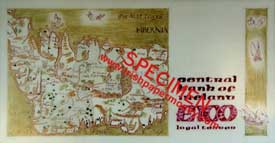
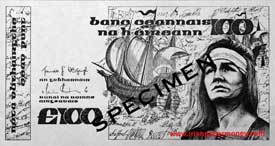
Access to the Central Bank of Ireland Archives, which were opened to public access in 2017, has revealed the progression of the development of a design for a Series B £100 Note, which was cancelled shortly before production around 1986. Much of the information here is based on a detailed examination of the data available in the archive. Very little was known about the design of this banknote until these data became available for study. All of the content on this page was first published in Coin News, December 2018.
The theme of the £100 note covers a period in Irish history of approximately one hundred and fifty years from ca1530, the start of the English conquest of Ireland, through to 1691, the flight of the ‘Wild Geese’ when some of the Catholic Irish lords went into exile along with their soldiers and extended families and followers, which resulted in the removal of the gaelic Irish aristocracy.
Servicon, the design team which designed all of the denominations of the Irish Series B banknotes envisaged that the £50 and £100 stood apart from the other denominations as they were less frequently used. They were more commonly seen in rural areas, at cattle marts and the like. The persons and activities depicted on the notes were therefore chosen to reflect the people: folk heroes. Music became the choice for the Series B £50 note, and the people themselves the choice for the £100.
The choice for the portrait was a legendary chieftain from the Elizabethan era, Grace O’Malley, Gráinne Mhaol [1] in Irish, known as Granuaile. Gráinne Mhaol was used for her signature on the note. She was chosen to represent the Irish people in general, as she had grown to become a folk hero. Her symbol is the ships she commanded, and is based on a carrack design from a 1638 map of Ireland by Gerard Mercator (1512–1594) [2]. It was commented on later, in 1984, by Anne Chambers [3], an expert on Granuaile, when she reviewed the designs for the Central Bank of Ireland, that although accurate for the period, the O’Malleys’ ships would have been galleys rather than Spanish style carracks [4].
On the earliest mock up in the Central Bank of ireland Archive, dated 1979, illustrated below, wild geese fly through the £100 on the front, and sea birds fly and nest in the £100 on the reverse (the geese were later moved to the reverse).
The background underlay is composed of signatures from a Petition of the House of Commons in 1640, a contemporary petition signed by many Irish people. It was changed from the background originally submitted on the first design in 1973 which was taken from an ‘undistinguished’ poem in Irish about Granuaile, the original of which is in the John Rylands Library, University of Manchester.
The background of signatures was later found to be unsuitable and reverted to the original poem in the final design stages around 1986 - an image with the poem as the background is not available. The signature background was considered unsuitable partly because it took too much from the 'gaelicness' of the note, being in English, and also they were considered to be too heavy an influence on the overall design.
A full mock-up of the note, submitted by Servicon to the Central Bank of Ireland in August 1979, pictured below, was broadly acceptable to the Governor and General Manager of the Currency Issue Dept. It shows all of the major design elements in place except the Gráinne Mhaol signature.
The portrait in this mock-up was based on Siobhán Mc Kenna (1923-1986) [5], a leading Irish stage and screen actress of the time. This portrait was rejected by the Central Bank of Ireland for several reasons, one being that the portrait of Grace O’Malley should not be based on a well-known living person. If a model was used for the portrait, then she should be anonymous. The second ship on the right would be removed in the final version in 1987.
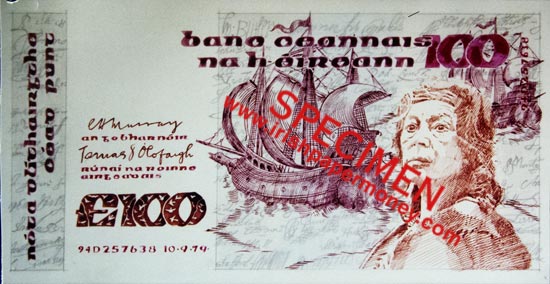
Central Bank of Ireland 100 Pound note, Series B face, 1979 design
The reverse of the banknote, pictured below, features a genealogical map of Ireland, with the localities of family names. The map represents the unity of Ireland. It is based on the 1567 map of ‘Hibernia: Insula non procul ab Anglia vulgare Hirlandia vocata’ by John Goghe [6], the earliest known map of the island of Ireland. An original of this map is in the National Archives in London.
An image of John Goghe's 1567 map is illustrated below, along with an extract cropped to show the portion of the map used on the banknote design.
Three elements from the map, including two ships, are featured in the printed panel to the right of the denomination area on the banknote

Central Bank of Ireland 100 Pounds, Series B reverse, 1979 design

Extract of the John Goghe's 1567 Hibernia map, illustrated below, showing the portion of the map which was used as a basis for the design of the Series B £100 note reverse

Hibernia: Insula non procul ab Anglia vulgare Hirlandia vacate' by John Goghe, 1567 [6. Source https://commons.wikimedia.org]
The ornamentation of the geese on the £100 numerals represents the ‘Flight of the Wild Geese’ [7] from Ireland at the end of the Jacobite–Williamite war [8]. This refers to the exile of the Irish forces lead by Patrick Sarsfield, Earl of Lucan, loyal to the Stuart King James II. Sarsfield had held off the army of William of Orange during the siege of Limerick in August-October 1691, after William’s earlier victories in the Battle of the Boyne in 1690 and at the battle of Aughrim in July 1691. As part of the Treaty of Limerick on 3 October 1691, the peace agreement allowed Sarsfield’s forces with their arms and banners and along with their families the option of sailing to France to join James II in exile.
The Treaty also gave guarantees of safety to the Catholic Lords and population who remained in Ireland. It had the effect of removing a powerful force of Catholic Irish soldiers and their leaders from the field on the island of Ireland, leaving the Catholic aristocracy and their followers who remained largely at the mercy of the Williamites.
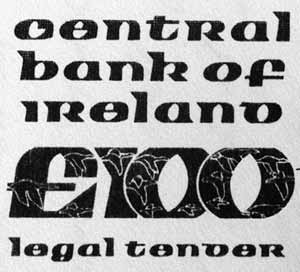
Detail of wild geese in flight on the Series B £100 denomination in numerals
Security features
The security features to be used on the £100 note were cutting edge for the time. The galleon would contain a latent image ‘£100’ on the hull. The yellow in the background was to be visible fluorescent ink, and background colours on the front were chosen, especially the yellow, so that they would drop out when photocopied. Colour photocopies were considered to be a significant threat in terms of a source of forgeries, easily available to a potential forger.
The black number 100 was to fluoresce red or green. The edge surrounding line on the front would be microprint intaglio, ‘Central Bank of Ireland’ repeated, this would be the only instance of the usage of English language on the face of a Series B banknote, and the only Series B denomination to contain microprinting [9].
Printing
Face: 3 colours intaglio, 3 colours litho. Reverse: 3 colours intaglio, 2 colours litho. The predominant colour was to be a strong red, as shown below in a test engraving of a version of the portrait which was not used. The banknote size would be 188 x 98 mm, 8 mm and 4 mm respectively larger than the £50 note. (Note, in the original design specifications, it was proposed that the £100 note would be the same size as the £50).

A 1984 engraving in the correct colours of a discarded version of the portrait for the Series B £100. This engraving was done to illustrate the portrait in its correct colour
The reverse was largely acceptable from the initial stages of the design. However, there were some significant corrections to be made, most notably in the spelling of CONACHT and ULSTER, which should have used old spellings as on the original map: 'CONAGHT' and 'ULSER'.
The portrait design remained stubbornly unsatisfactory, and was revised and reworked several times.
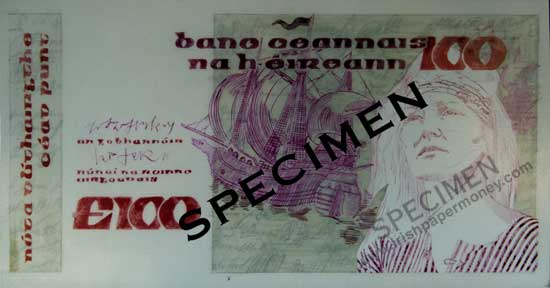
An early revision of the Series B £100 design with a redesigned portrait
Below is a 1984 mock-up of the £100 note, with the spelling of CONACHT and ULSTER corrected to use the old spellings as on the original map: 'CONAGHT' and 'ULSER'. The wild geese are fully developed, though still in need of further adjustment so as to not extend out of the numerals. In a later design revision the second ship on the right would be removed, possibly to facilitate an unobstructed field for the serial number.
The portrait design was still unsatisfactory. It was still considered to have a frowning effect, but was closer to the desired look. This is close to what the final note would have looked like. The portrait from this print was used in an engraving, pictured above, to illustrate the red colour to be used on the final note.

![]()
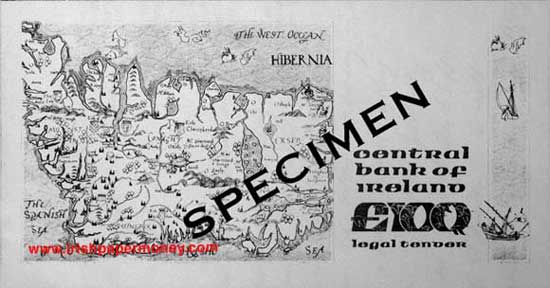
A 1984 mock-up of the Series B 100 Pound note, with design revisions made

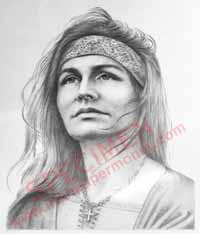
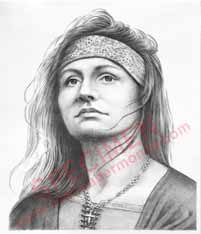
Three portrait designs submitted by Bradbury Wilkinson show the variance in thought over what the 'Pirate Queen' should look like
In November 1985 Servicon and the Central Bank of Ireland team all strongly agreed on the usage of one of the portraits submitted by Bradbury Wilkinson. However, there remained disagreement over the background script, Servicon still wanting to use the signatures, the Central Bank wanting to use the poem. The Governor (O'Cofaigh) decided to use the poem, and Servicon were asked to supply a background script based on the poem about Granuaile, and also to create a ‘signature’ of her name, similar to that on other denominations.
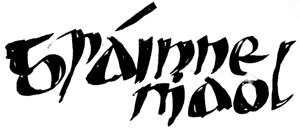
Signature artwork for Gráinne Mhaol, spelt in the old style with a buailte (dot) over the M, denoting genitive case
Illustrated above is some development artwork for Granualie’s signature, which is similar in style to that of Queen Medb on the £1 note. Various other design elements were to be checked and adjusted, including the spacing out of the numerals of the £100 on the note. Bradbury Wilkinson [10] then proceeded to the proof stage. This is the last recorded mention of a proof, and an image of it has not yet been seen.
1986 Final design stages and reviews of the need for a £100 note
Arguments for and against issuing the £100 denomination had continued throughout its development. There was always an underlying unease about the existence of a £100 denomination. Ireland had exchange controls in place at the time, and it was felt by some agencies that high denomination notes could help facilitate the illegal movement of cash. A recommendation from exchange control in a letter to the Central Bank of Ireland, dated 8th June 1979 was that the bank should cease issuing £50 and £100 notes. The Central Bank however, favoured retaining the denominations.
In February 1982 as Maurice Doyle became Secretary of the Department of Finance, he expressed himself in agreement that for capital control and tax evasion reasons, the Central Bank of Ireland should not have the £100 denomination. Mr. Doyle’s opinion on this would be critical, as he would become Governor of the Central Bank of Ireland on 1 May 1987.
At the stage of the 1986 review, the Currency Department was already considering a size reduction of the banknotes in circulation, in line with international trends. It was the stated aim of the Currency Department to reduce the sizes of all denominations. It was considered logical however to proceed with the £100 as a note larger than the £50, and to start size reductions with the £1 note.
In the event, the £1 note was replaced by a coin in 1990, the £100 note was cancelled, and the other Series B banknote denominations were replaced, starting in 1992, by the much smaller sized banknotes of the C Series, rather than reduced size Series B designs.
The £100 note design had taken so long to complete that the impending development of the C Series was catching up on it. The lack of a real need for a £100 note was a persistent fact that had nagged away at the project throughout the 1980s.
Also, and possibly critically for the project, once Maurice Doyle became Governor on 1st May 1987 the opinion of the Governor would likely have altered from being in favour of the £100 denomination to being against it, as Mr. Doyle had been an opponent of it when in the office of Secretary of the Department of Finance. This may well have been a fatal blow to the introduction of the note. It would be ten years before a new £100 design would be introduced, in the form of the C Series Parnell £100 in 1996.
Bradbury Wilkinson was taken over by De La Rue [11] in March 1986. This does not appear to have disrupted work on the development of the £100 note to any degree. However, work on the note appears to have come to a halt sometime in late 1986 or early 1987, and this points towards it being likely that it was abruptly cancelled by Maurice Doyle when he became Governor in early 1987.
Likely prefix letters
Based on what is known of the Series B prefixing system it is likely that had the £100 note been issued around its original intended time, it would possibly have started with prefix ADL (ADL to LDL was used up on £1 notes dated 14.09.83, which was out of place in the pattern of £1 note sequences. L did not belong as a base letter to £1 notes.), with LLL for specimens and replacements. Other prefixes ending in L were used on £20 notes commencing 18.11.87, which is likely after the final cancellation of the £100 denomination.
Between the 14th and 16th centuries the O’Malley Clan were a mid-level power in the west of Ireland. They taxed and raided the area under their control and traded and fought with other clans. They built several castles on the shorelines to protect their interests. By the 16th century the clan were quite strong seafarers which was uncommon among Irish clans of the time.
The most famous leader of this clan was Grace O’Malley known as Grainne Mhaol, or Granuaile (ca1530–1603). She was the most powerful woman in 16th century Ireland, and was mentioned as having 11 castles, and a fleet of up to forty ships under her control including three galleys, the only galleys in Ireland at the time.
In Granuaile’s time the clan controlled an area around South West County Mayo, Clew Bay, Achill Island, and Clare Island [12]. Her fleet controlled much of the west coast of Ireland and she traded as far afield as Scotland, Spain and Portugal. She has been referred to as Ireland’s pirate queen. This was during the era of the Tudor conquest of Ireland, and the largely autonomous Irish lords were being forced to accept English overlordship.
Granuaile was fighting the English lords who were attempting to take control of Connacht. Although a woman, it is said that it was she who held the loyalty and respect of the fighting clansmen, and she took over the clan leadership after her husband, Richard Burke, was killed. She had been taken to sea and raised to lead from an early age by her father, Eoghan Dubhdara Ó’Máile, and she was reputed to have been a great leader of fighting men. It came naturally to her.
When the English governor of Connacht, Sir Richard Bingham, attacked Granuaile and her followers, imprisoning her half brother and her two sons she made a historic sea journey in 1593 to the court of Queen Elizabeth I, sailing up the Thames to seek an audience with the Queen [13]. She is believed to have spoken Latin with the Queen, their only common language. She succeeded in having Bingham removed, in exchange for withdrawing her support for rebel Irish lords. Granuaile soon reneged on this, and supported the Irish lords in the Nine Years’ War [14], a rebellion, mostly in Ulster, lead by Hugh O’Neill, Earl of Tyrone [15] and his allies. O'Neill and the Irish lords were defeated and went into exile (the Flight of the Earls [16]), allowing for the Plantation of Ulster [17], and the further consolidation of English rule in Ireland.
She remained famous among the Irish people long after her death. Her memory survived in Irish folklore, as a heroine, identified with many typical Irish characteristics, among a people who needed heroes. She is mentioned by name ‘Grany O’Mayle’ on the Brazio Map of Ireland dating from 1590 and on other maps of Ireland of the era [18], an indication of her power at the time.
There are several accepted spellings of her name: Grace O’Malley, in English; Gráinne Ní Mháille in Irish. She was known as Gráinne Mhaol (Maoil coming from the Umhalls, the baronies of Murrisk and Borrishoole, the historic territory of the O’Malley’s); or Anglicised to Granuaile. The Central Bank of Ireland considered that if Gráinne Ní Mháille was not used in full on the note, then Granuaile would be an acceptable spelling. The last known version being worked on was Gráinne Mhaol, spelt in the old style.
Original Version (2018)
Original [print] version (2018): Mac Devitt, M., 'The Hundred Pound Note That Never Was...', Coin News, December 2018, p74.
References
The content of this page is based closely on a Coin News article (2018), cited above, which is the publication of research carried out at the Central Bank of Ireland Archives, Dublin on 24 May 2018.
B. Central Bank of Ireland Archives, Dublin. Referred to as CBIAR in the text. [Accessed 24 May 2018].
All images reproduced by curtsey of the Central Bank of Ireland Archives.
Background references [Last retrieved 30.05.24]
1. Grace O'Malley, Gráinne Mhaol Pirate Queen of Connacht <https://www.historyireland.com/early-modern-history-1500-1700/grainne-mhaol-pirate-queen-of-connacht-behind-the-legend/>
2. Gerard Mercator (1512–1594) <https://mathshistory.st-andrews.ac.uk/Biographies/Mercator_Gerardus/>
3. Anne Chambers, Grace O'Malley website. <http://www.graceomalley.com/>
4. Differences between Galleys and Carracks <https://www.britannica.com/technology/galley-ship> <https://www.britannica.com/technology/carrack>
5. Siobhán Mc Kenna <https://www.irishtimes.com/opinion/filth-at-the-abbey-an-irishwoman-s-diary-on-siobhán-mckenna-and-archbishop-mcquaid-1.4216094>
6. Illustration of the 1567 map of Hibernia by John Goghe. Both map images used on this page are a scaled down version of a much higher resolution image (1200dpi) of the map 'Hibernia: Insula non procul ab Anglia vulgare Hirlandia vocata' by John Goghe, 1567 (which loosely translates as 'Hibernia: an island not far from England, commonly called Ireland'), originally retrieved from wikimedia: <https://commons.wikimedia.org/wiki/File:Hibernia,_Anglia_vulgare_Hirlandia_vocatur_-_map_of_Ireland_by_John_Goghe,_1567.jpg>
Further information on Goghe's 1567 map of Ireland is available from several sources.
How Ireland was mapped: <http://news.bbc.co.uk/2/hi/news/8307233.stm>
The digital analysis and curation of sixteenth century maps.
<http://www.e-perimetron.org/Vol_14_2/Porter_et_al.pdf>
Colonial Cartography in a European Setting <https://press.uchicago.edu/books/HOC/HOC_V3_Pt2/HOC_VOLUME3_Part2_chapter55.pdf>
The map dimensions are listed as 40.6 cm x 53.3 cm, and the scale is said to be approximately 1 inch to 16 miles (1cm to 65 km) [Data from National Archives.gov.uk Catalogue description: <https://discovery.nationalarchives.gov.uk/details/r/C3982012>
7. Flight of the Wild Geese <https://www.jstor.org/stable/29735753>
8. General references on the Jacobite–Williamite war. <https://www.theirishstory.com/2018/07/08/the-jacobite-williamite-war-an-overview/>
Patrick Sarsfield, Earl of Lucan. <https://www.libraryireland.com/biography/PatrickSarsfield.php>
Stuart King James II. <https://www.bbc.co.uk/history/historic_figures/james_ii.shtml>
William of Orange. <https://www.historic-uk.com/HistoryUK/HistoryofEngland/William-Of-Orange/>
The siege of Limerick. <https://irelandxo.com/ireland-xo/history-and-genealogy/timeline/siege-limerick>
Battle of the Boyne. <https://www.bbc.co.uk/programmes/p00vmmzm>
Battle of Aughrim. <https://www.historyireland.com/early-modern-history-1500-1700/the-battle-of-aughrim/>
Treaty of Limerick. <http://indigo.ie/~wildgees/treaty.htm>
9. Microprinting. <https://mste.illinois.edu/dildine/times/money/>
10. Bradbury Wilkinson. <https://snaccooperative.org/ark:/99166/w65n29nx>
11. De La Rue. <https://www.delarue.com/about/our-history>
12. South West County Mayo
Clew Bay. <https://www.mayo-ireland.ie/en/wild-atlantic-way/clew-bay.html>
Achill Island. <http://achilltourism.com/history/>
Clare Island. <https://www.clareisland.ie/see/granuaile-castle>
13. Grace O'Malley's meeting with Queen Elizabeth <http://www.graceomalley.com/index.php/grace-omalley/when-the-sea-queen-met-the-virgin-queen>
14. Nine Years’ War. <https://www.nam.ac.uk/explore/nine-years-war>
15. Hugh O’Neill, Earl of Tyrone
<https://www.irishtimes.com/culture/hugh-o-neill-romantic-hero-or-power-hungry-politician-1.2743810>
<https://www.libraryireland.com/biography/HughONeillEarlofTyrone.php>
16. Flight of the Earls. <https://www.historyireland.com/early-modern-history-1500-1700/flight-of-the-earls-changing-views-on-oneills-departure-from-ireland/>
17. Plantation of Ulster. <https://www.libraryireland.com/HullHistory/Plantation1.php>
18. Early Maps of Ireland mentioning Grace O'Malley. <https://blog.nationalarchives.gov.uk/blog/meeting-grace-omalley-irelands-pirate-queen/>
1 Pound Ploughman
5 Pounds Ploughman
10 Pounds Ploughman
20 Pounds Ploughman
50 Pounds Ploughman
100 Pounds Ploughman
Irish Ten Shilling Notes
1 Pound Note Lady Lavery
5 Pounds Lady Lavery
10 Pounds Lady Lavery
20 Pounds Lady Lavery
50 Pounds Lady Lavery
100 Pounds Lady Lavery
1 Pound Note, Queen Medb
5 Pound Note, John Scotus Eriugena
10 Pound Note, Jonathan Swift
20 Pound Note, W. B. Yeats
50 Pound Note, Turlough O'Carolan
100 Pound Note, Grace O'Malley
5 Pound Note, Sister Catherine McAuley
10 Pound Note, James Joyce
20 Pound Note, Daniel O'Connell
50 Pound Note, Douglas Hyde
100 Pound Note, Charles Stewart Parnell
Northen Ireland Polymer notes
Bank of Ireland Polymer Notes
Danske Bank Polymer Notes
Ulster Bank Polymer Notes
Special Sections and Articles
The Transition of Irish Currency, Irish banknotes 1918–1928
The Partition of Irish Currency, Irish banknotes 1928–1930
Banknote Design Evolution 1824 to 1916
Irish Three Pound Notes
Contemporary Forgeries of Early Irish Banknotes, ca1800-1930
Limerick Soviet Notes
Irish World War 2 Banknote Issues
Low Number Irish Banknotes
Irish Joint Stock Banks of Note Issue from 1783
Irish Legal Tender Note Specimens
Ploughman Scan Survey (PSS)
![]() Stable version. Last update 24.08.24.
Stable version. Last update 24.08.24.